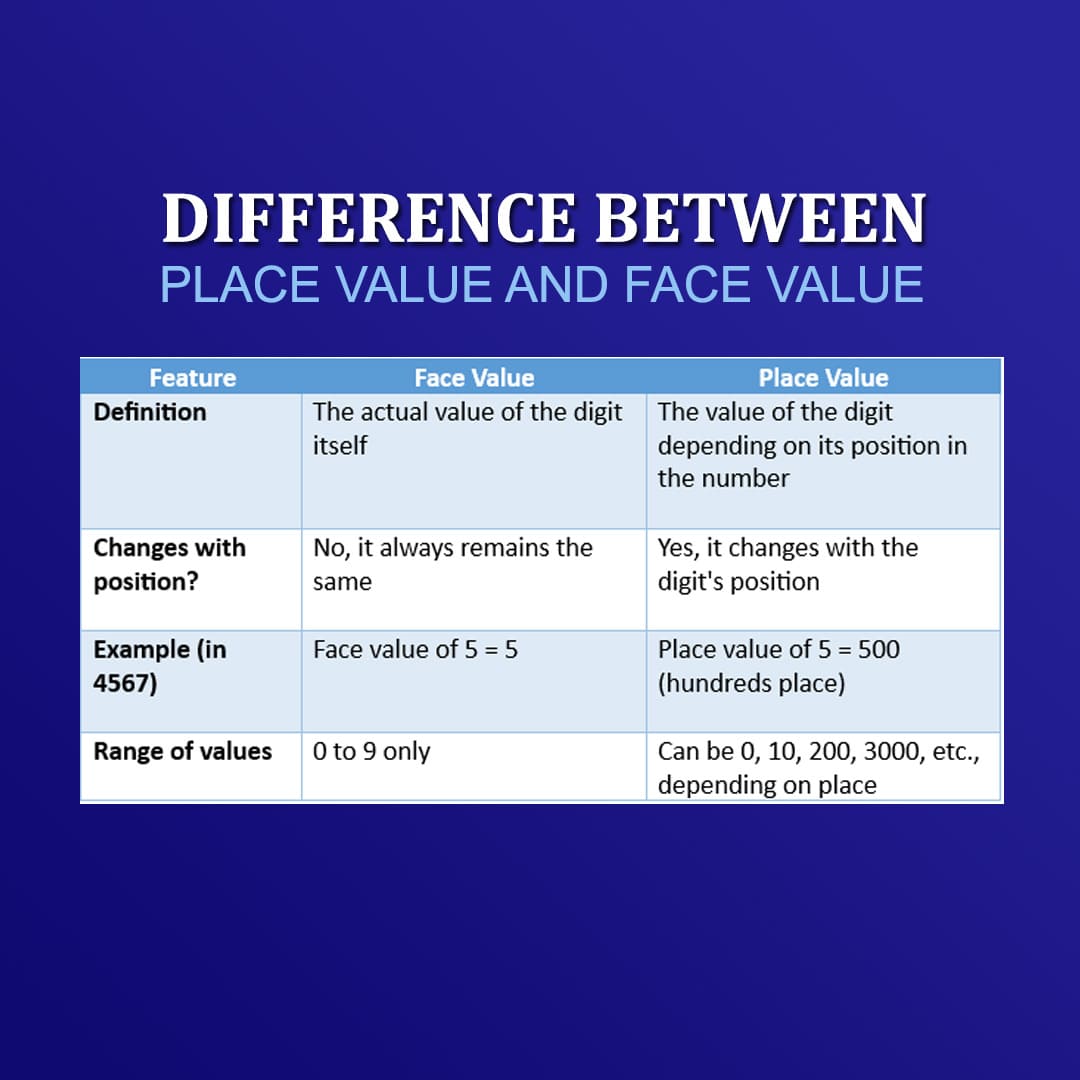

Please enter the code we just sent to whatsapp 91-11-46710500 to proceed
Didn't Receive OTP?

For younger learners, mathematical concepts involved numbers and the function of each digit. Two important ideas in this context are place value and face value which may seem synonymous but are quite different in practice. A child must know the difference between place and face value in order to develop number sense.
In this article, we shall discuss what is face value in mathematics, place value examples, and a clear example comparing face and place values.
A digit's face value in a number is simply the digit itself; thus, it is independent of the placement of the digit in the number.
Put simply, face value always remains the same; it is just the digit itself.
Face Value Example:
In the number 5678:
Face value of 5 = 5
Face value of 6 = 6
Face value of 7 = 7
Face value of 8 = 8
In any digit number, the face value of a digit remains the same irrespective of wherever the digit is placed.
A digit acquires its place value depending upon its position in the number. It is the product of the digit with the value of the place in which it is put-one, ten, hundred, thousand, and so on.
In simple language: the place value changes with the change in the location of the digit.
Examples of Place Value:
In the number 5678:
Place value of 5 = 5000 (thousand)
Place value of 6 = 600 (hundred)
Place value of 7 = 70 (tens)
Place value of 8 = 8 (ones)
So here, the face value of 7 is just 7, whereas its place value in 5678 is 70.
To clear the concept, here's a simple comparison:
|
Feature |
Face Value |
Place Value |
|---|---|---|
|
Definition |
The actual value of the digit itself |
The value of the digit depending on its position in the number |
|
Changes with position? |
No, it always remains the same |
Yes, it changes with the digit's position |
|
Example (in 4567) |
Face value of 5 = 5 |
Place value of 5 = 500 (hundreds place) |
|
Range of values |
0 to 9 only |
Can be 0, 10, 200, 3000, etc., depending on place |
This table clearly states the difference between Place Value and Face Value.
Let us take the number 4325:
Digit 4
Face Value=4
Place Value=4000 (thousands place)
Digit 3
Face Value=3
Place Value=300 (hundreds place)
Digit 2
Face Value=2
Place Value=20 (tens place)
Digit 5
Face Value=5
Place Value=5 (ones place)
Therefore, the face value and place value example for 4325 puts forth the key difference.
To read large numbers correctly (to distinguish 4025 from 4250);
To add, subtract, multiply, and divide numbers;
To form the basis of our decimal number system (base 10).
More Quick Practice Examples
Number: 2516
Face value of 5 = 5
Place value of 5 = 500
Number: 7084
Face value of 8 = 8
Place value of 8 = 80
Number: 9231
Face value of 9 = 9
Place value of 9 = 9000
Such examples of place value make the distinctions crystal clear.
Face value in maths, is simply the digit.
Place value, is the value given to the digit according to its position.
The main difference between the two is that face value is constant, whereas place value varies as regards the position of the digit in the number.
Using such examples of face value and place value based on a few numbers like 5678 and 4325 makes learning easier for students.
Both these concepts help understand numbers in the branch of mathematics and create a platform on which various other topics in arithmetic and algebra rest.
Alpha Math offers a game-based learning experience with a unique four-step approach to mastering every concept in math. Schedule a Free Class Now